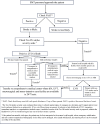Comparison of prehospital stroke assessment scales for acute ischemic stroke with large vessel occlusion within six hours of onset: A single-center study in Eastern Taiwan
- PMID: 40741612
- PMCID: PMC12306891
- DOI: 10.4103/tcmj.tcmj_191_24
Comparison of prehospital stroke assessment scales for acute ischemic stroke with large vessel occlusion within six hours of onset: A single-center study in Eastern Taiwan
Abstract
Objectives: In Taiwan, acute ischemic stroke (AIS) with large vessel occlusion (LVO) remains a significant health concern. Reperfusion therapy is more effective if the patient arrives at the medical center within the early time window, emphasizing the importance of prehospital stroke assessment to identify LVO and rapid transfer. This study focused on Eastern Taiwan, where the Hualien Tzu Chi Hospital is the sole comprehensive stroke center. We compared different prehospital stroke assessment scales in identifying LVO.
Materials and methods: We reviewed 598 patients with acute stroke admitted to our hospital's emergency department between April 1, 2021, and March 31, 2022. Of these, 110 AIS cases presenting within 6 h of symptom onset were retrospectively analyzed using the medical records and National Institute of Health Stroke Scale (NIHSS) scores to evaluate the efficacies of prehospital stroke scales, including our institution's Tzu Chi Stroke Severity Scale and its modified version. LVO was defined as occlusion of the anterior cerebral artery, middle cerebral artery, and its main branches, intracranial carotid arteries, and vertebrobasilar arteries.
Results: Among 110 patients, 39.1% had LVO, which showed a higher mortality rate and prevalence of atrial fibrillation. LVO had higher NIHSS scores and longer hospital stays. The Vision Aphasia Neglect (VAN) Scale and Modified Tzu Chi Stroke Severity Scale showed the highest sensitivity, with the latter also exhibiting the highest sensitivity for posterior circulation LVO.
Conclusion: The VAN and the modified Tzu Chi Stroke Severity Scale offer comparable sensitivity for detecting LVO in the prehospital setting. Our study supports the adoption of the modified Tzu Chi scale in the regional emergency medical service transfer algorithm for LVO detection for timely intervention.
Keywords: Acute ischemic stroke; Eastern Taiwan; Large vessel occlusion; Prehospital stroke assessment; Vascular neurology.
Copyright: © 2024 Tzu Chi Medical Journal.
Conflict of interest statement
There are no conflicts of interest.
Figures


Similar articles
-
Performance of Automated Algorithm in Large and Medium Vessel Occlusion Detection: A Real-World Experience.AJNR Am J Neuroradiol. 2025 Mar 4;46(3):476-482. doi: 10.3174/ajnr.A8509. AJNR Am J Neuroradiol. 2025. PMID: 39326885
-
The risk of endovascular thrombectomy in acute ischemic stroke patients with large vessel occlusions harboring unruptured intracranial aneurysms.BMC Neurol. 2025 Jul 1;25(1):269. doi: 10.1186/s12883-025-04283-5. BMC Neurol. 2025. PMID: 40596974 Free PMC article.
-
Numerical Cincinnati Stroke Scale Versus Stroke Severity Screening Tools for the Prehospital Determination of Large Vessel Occlusion.Prehosp Emerg Care. 2025 Jan 23:1-8. doi: 10.1080/10903127.2024.2430442. Online ahead of print. Prehosp Emerg Care. 2025. PMID: 39561317
-
Prehospital stroke scales and large vessel occlusion: A systematic review.Acta Neurol Scand. 2018 Jul;138(1):24-31. doi: 10.1111/ane.12908. Epub 2018 Feb 11. Acta Neurol Scand. 2018. PMID: 29430622
-
Accuracy of Prediction Instruments for Diagnosing Large Vessel Occlusion in Individuals With Suspected Stroke: A Systematic Review for the 2018 Guidelines for the Early Management of Patients With Acute Ischemic Stroke.Stroke. 2018 Mar;49(3):e111-e122. doi: 10.1161/STR.0000000000000160. Epub 2018 Jan 24. Stroke. 2018. PMID: 29367333
References
-
- Ministry of Health and Welfare. 2020 Cause of Death Statistics. MOHW; 2021. [[Last accessed on 2022 Sep 02]]. Available from: https://www.mohw.gov.tw/cp-5256-63399-2.html .
-
- Yoshimura S, Sakai N, Yamagami H, Uchida K, Beppu M, Toyoda K, et al. Endovascular therapy for acute stroke with a large ischemic region. N Engl J Med. 2022;386:1303–13. - PubMed
LinkOut - more resources
Full Text Sources
Miscellaneous
